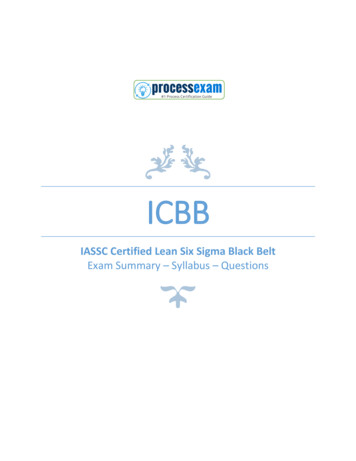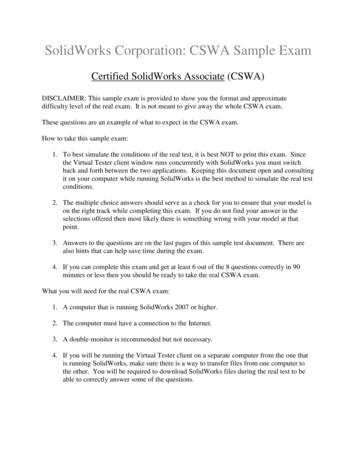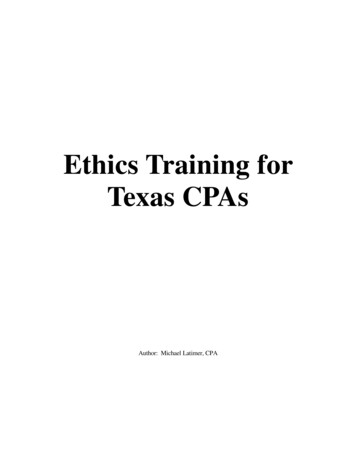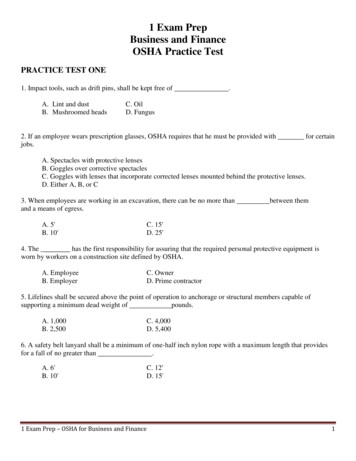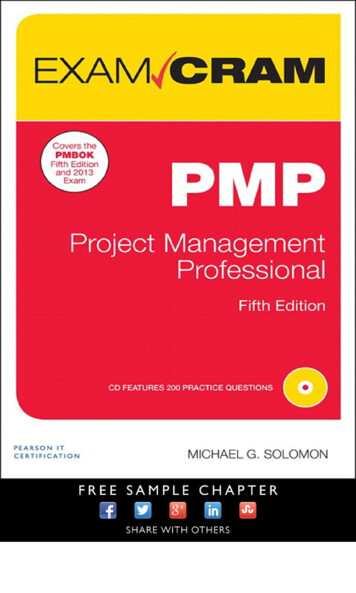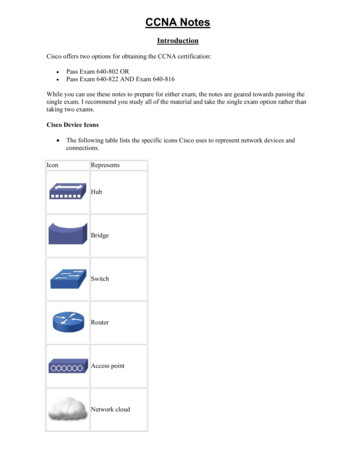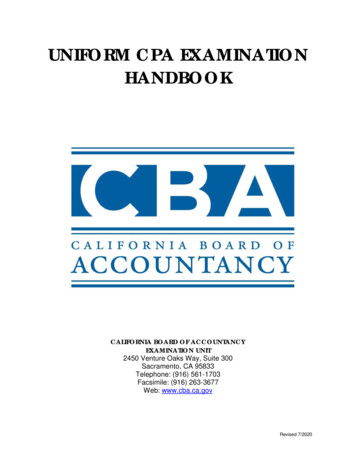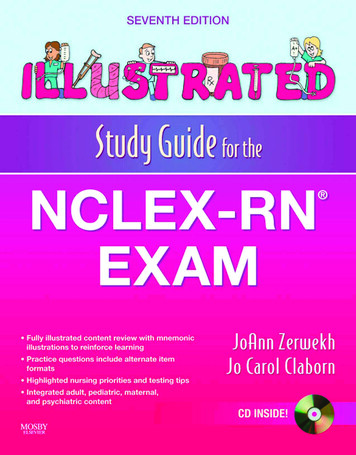
Transcription
Study Guide for theNCLEX-RNEXAM
This page intentionally left blank
SEVENTH EDITIONStudy Guide for theNCLEX-RNEXAM EditorsJoAnn Zerwekh, EKH, MSN, EdD, RNJo Carol Claborn, MS, RN
3251 Riverport LaneSt. Louis Missouri 63043ISBN: 978-0-323-05664-9ILLUSTRATED STUDY, GUIDEFOR THE NCLEX-RN EXAM 2010, 2006 by Mosby, Inc., an affiliate of Elsevier Inc.No part of this publication may be reproduced or transmitted in any form or by any means, electronic ormechanical, including photocopying, recording, or any information storage and retrieval system, withoutpermission in writing from the publisher. Details on how to seek permission, further information about thePublisher’s permissions policies and our arrangements with organizations such as the Copyright ClearanceCenter and the Copyright Licensing Agency, can be found at our website: www.elsevier.com/permissions.This book and the individual contributions contained in it are protected under copyright by the Publisher(other than as may be noted herein).NoticesKnowledge and best practice in this field are constantly changing. As new research and experiencebroaden our understanding, changes in research methods, professional practices, or medical treatment maybecome necessary.Practitioners and researchers must always rely on their own experience and knowledge in evaluatingand using any information, methods, compounds, or experiments described herein. In using suchinformation or methods, they should be mindful of their own safety and the safety of others, includingparties for whom they have a professional responsibility.With respect to any drug or pharmaceutical products identified, readers are advised to check the mostcurrent information provided (i) on procedures featured or (ii) by the manufacturer of each product to beadministered, to verify the recommended dose or formula, the method and duration of administration,and contraindications. It is the responsibility of practitioners, relying on their own experience andknowledge of their patients, to make diagnoses, to determine dosages and the best treatment for eachindividual patient, and to take all appropriate safety precautions.To the fullest extent of the law, neither the Publisher nor the authors, contributors, or editors, assumeany liability for any injury and/or damage to persons or property as a matter of products liability,negligence or otherwise, or from any use or operation of any methods, products, instructions, or ideascontained in the material herein.NCLEX , NCLEX-RN , and NCLEX-PN are registered trademarks of the National Council of StateBoards of Nursing, Inc. Nursing diagnoses from Nursing Diagnoses–Definitions and Classification2009-2011 2009, 2007, 2005, 2003, 2001, 1998, 1996, 1994, NANDA International. Used by arrangementwith Wiley-Blackwell Publishing, a company of John Wiley & Sons, Inc.International Standard Book Number: 978-0-323-05664-9Managing Editor: Nancy L. O’BrienPublishing Services Manager: Anne AltepeterSenior Project Manager: Cheryl A. AbbottDesign Direction: Amy BuxtonMultimedia Producer: Dave RushingWorking together to growlibraries in developing countrieswww.elsevier.com www.bookaid.org www.sabre.orgPrinted in The United States of AmericaLast digit is the print number: 9 87654321
ContributorsJoanna G. Barnes, MSN, RNGrayson County Community CollegeDenison, TexasJeannette Gloria Brown, MSN, RNC-OB,C-EFM, RNVirginia Commonwealth UniversityRichmond, VirginiaMarianne Call, MN, RNGeriatric Behavioral HealthEast Jefferson General HospitalMetairie, LouisianaSharon I. Decker, RN, PhD, ACNS-BC, ANEFProfessor and Director of Clinical SimulationsCovenant Health System Endowed Chair in Simulationand Nursing EducationTexas Tech University Health Science CenterLubbock, TexasBarbara S. Devitt, MSN, RNLecturerLouise Herrington School of NursingBaylor UniversityDallas, TexasAshley Garneau, MS, RNNursing FacultyGateway Community CollegePhoenix, ArizonaLt. Col. (Ret.) Michael W. Hutton, MSN, RNInstructorBlinn CollegeBryan, TexasSusan B. Priest, MSN, RN, CNSDirector, Health and Medical ProgramsContinuing Education Workforce DevelopmentAdjunct Faculty, Associate Degree NursingAlvin Community CollegeAlvin, TexasCatherine Rosser, EdD, CNA-BC, RNUndergraduate Program DirectorLouise Herrington School of NursingBaylor UniversityDallas, TexasLinda Stevenson, PhD, RNAssistant ProfessorLouis Herrington School of NursingBaylor UniversityDallas, TexasMary Ann Yantis, BS, MS, PhD, RNAssociate Professor of NursingLouis Herrington School of NursingBaylor UniversityDallas, Texasv
This page intentionally left blank
ReviewersJudy Cole, MSN, RNCMaternal Child EducatorSaint Francis Hospital, MemphisMemphis, TennesseeJolee M. Preston, MSN, RNAssistant ProfessorJefferson College of Health SciencesRoanoke, VirginiaFaith Darilek, MSN, RNNursing ProfessorThe Victoria CollegeVictoria, TexasSharon Redding, MN, RN, CNEAssociate Professor of NursingCollege of Saint MaryAlegent Bergon Mercy Medical CenterOmaha, NebraskaMary M. Fabick, MEd, MSNAssociate Professor of NursingMilligan CollegeMilligan College, TennesseeCene’ Gibson, MSN, ARNPFamily Nurse PractitionerFamily Healthcare and Minor Emergency ClinicYukon, OklahomaMargaret M. Gingrich, MSN, RNProfessorHarrisburg Area Community CollegeHarrisburg, PennsylvaniaSarah M. Howell, MSN, RNAssistant Professor of NursingMississippi University for WomenColumbus, MississippiKatherine RobertsAssistant ProfessorJoann Gay Dishman Department of NursingLamar UniversityBeaumont, TexasDonna Wilsker, MSN, BSN, RNAssistant ProfessorLamar UniversityBeaumont, TexasConnie S. Wilson, EdD, RN, CNEProfessorUniversity of IndianapolisIndianapolis, Indianavii
This page intentionally left blank
PrefaceThis seventh edition of Illustrated Study Guide for theNCLEX-RN Exam continues to provide an up-to-datereview book illustrated with graphics, pictures, and cartoonimages to enhance your review and retention of criticalnursing information. The book contains information specifically designed to assist you in preparing for the NationalCouncil Licensure Examination for Registered Nurses(NCLEX-RN ). This text emphasizes the integratedapproach to nursing practice that the NCLEX-RN isdesigned to test. The book’s primary purpose is to assist youto thoroughly review facts, principles, and applications ofthe nursing process. It should alleviate many of the concernsyou may have about what, how, and when to study.We have spent a great deal of time studying the NCLEXRN test format and have incorporated that information intothis book. We have included discussion and examples of thealternate format questions. In our review courses, which wehave taught across the country, we have identified specificstudent needs and have correlated this information with thetest plan in order to develop this study guide. Study questions are at the end of each chapter to help you check yourlevel of comprehension. In addition, there is a CD-ROMin the back of this text that contains questions for practicingyour testing skills.We have designed graphics that highlight importantinformation to make the book more visually appealing:ALERT Alert! identifies important concepts that arereflected on the RN Practice Analysis from the NationalCouncil of State Boards of Nursing, Inc.Nursing Priority assists to distinguish priorities ofnursing care.Adult disease conditions are easily located by thisdesign element.Pediatric disease conditions are easily located by thisdesign element.Self-Care and Home Care can be found under theNursing Interventions section.Medication information is easily found in chapterappendixes. High-Alert Medications identified by The Joint Commission and the Institute for Safe Medication Practices arenoted by this symbol.The comments from our review course participants, aswell as extensive faculty reviews on our sixth edition, havehelped to shape the development of this seventh edition. Wehope this text will prove to be even more beneficial tonursing faculty, students, and graduate nurses. Thank youfor allowing us to be part of your success in nursing.JoAnn ZerwekhJo Carol Clabornix
This page intentionally left blank
AcknowledgmentsWe wish to express our appreciation to our children—TylerZerwekh and Ashley Garneau, Mike Brown, KimberleyAultman, and Jaelyn Conway—for their continuing supportas their mothers wrote, rewrote, and put together anotheredition of this book. To Robert and John, thank you for yourtolerance, love, and willingness to continue to share andsupport us in the midst of our hectic professional lives.A special note of thanks to C.J. Miller, RN, BS, ourcartoonist, who has worked with us from the beginning ofthe Memory Notebooks of Nursing and the past few editionsof Nursing Today: Transition and Trends, and more recentlywith the Mosby’s Memory Notecard series. She continues tobrighten our day and bring to all of our books images andcartoons that are so unique.The revision of a book offers the opportunity to beresponsive to nursing faculty and students who have utilizedthe book. We appreciate their comments and suggestionsfor the production of this seventh edition. It is our pleasureto express an appreciation to the individuals who assisted usin the technical preparation and production of this edition.Our sincere appreciation to:Elaine Nokes, our administrative assistant, who keepseverything organized and running smoothly for ourbusiness.Kristin Green, senior editor, whose calm demeanor andflexibility with our schedules supported us as we worked allthe way to the last possible minute.Cheryl Abbott, senior project manager, who monitoredthe production of this book and kept us on schedule.Thank you to all!xi
This page intentionally left blank
Contents1 Testing Strategies for the NCLEX-RN Examination, 1Test Plan, 1Integrated Processes, 1Areas of Client Needs, 2What Is Computer Adaptive Testing?, 3Taking the NCLEX Examination, 4Application, 4Scheduling the Examination, 4Testing Center Identification, 4Day of the Examination, 4Testing, 4Test Results, 5Successful Test Taking on the NCLEX Exam, 5NCLEX Test-Taking Strategies, 5Management of Client Care, 6Establishing Nursing Priorities, 7Strategies for Evaluating Multiple-Choice Questions, 9Alternate Format Questions, 14Therapeutic Nursing Process: Principles ofCommunication, 16Tips for Test-Taking Success, 19Study Habits, 19Study Effectively, 19Set a Study Goal, 20Group Study, 21Testing Practice, 21Decrease Anxiety, 21Communicable Diseases, 27Varicella (Chicken Pox), 28Parotitis (Mumps), 28Rubeola (Measles, Hard Measles, Red Measles), 29Rubella (German Measles, Three-DayMeasles), 29Roseola Infantum (Exanthema Subitum), 29Diphtheria, 29Pertussis (Whooping Cough), 30Tetanus (Lockjaw), 30Poliomyelitis, 30Scarlet Fever (Scarlatina), 31Infectious Mononucleosis, 31Poisoning, 31General Principles, 31Salicylate Poisoning, 31Acetaminophen Poisoning, 32Lead Poisoning, 32Long-Term Care, 33Chronic Illness, 33Nursing Considerations, 33Chronically Ill Pediatric Client, 33Rehabilitation, 34Goals of Rehabilitation, 34Psychologic Responses to Disability, 34Home Health Care, 35Nutrition, 35Dietary Considerations Throughout the Life Span, 35Nutritional Assessment, 38Diet Therapy for High-Level Wellness, 38Therapeutic Meal Plans, 392 Health Implications Across the Life3 Concepts of Nursing Practice, 43Growth and Development, 23Anticipatory Guidance for the Family of an Infant, 23Anticipatory Guidance for the Family of a Toddler, 23Anticipatory Guidance for the Family of a Preschooler, 25Anticipatory Guidance for the Family of a School-AgeChild, 25Anticipatory Guidance for the Family of an Adolescent, 26Anticipatory Guidance for the Adolescent, 26Health Implications and Guidance for Adults and OlderAdults, 27Basic Human Needs, 43Health Assessment, 43Subjective Health Assessment, 43Nursing Assessment, 44Health Promotion, 45Levels of Prevention, 45Health Teaching, 45Principles of Client Education, 45End-of-Life Care, 47Physical Management of Symptoms, 47Postmortem Care, 48Span, 23xiii
xivContentsBasic Nursing Skills, 48Body Alignment and Range of Motion, 48Asepsis, 48Wound Care, 49Specimen Collection, 51Heat and Cold Applications, 51Vital Signs, 51Immobility, 52Adverse Physical Effects of Immobility, 52Adverse Psychologic Effects of Immobility, 53Pain, 53Classification of Pain, 53Pain Characteristics, 54Non-Drug Pain Relief Measures, 55Medications for Pain Relief, 55Barriers to Pain Management, 57Palliative Pain Relief, 57Perioperative Care, 57Preoperative Care, 57Day of Surgery, 59Anesthesia, 59Immediate Postoperative Recovery, 60General Postoperative Care, 624 Control Functions andManagement, 69Legal Aspects, 69Nursing Practice Regulations, 69Liability for Actions, 69Civil Torts, 70Protective Procedures, 71Responsibility for Professional Practice, 73Specific Situations of Risk, 73Legal Documents, 74Emergency Response Plans, 75Ethical Concerns, 76Management Concepts, 76Client Care Assignments and Delegation, 76Quality Management, 785 Pharmacology, 81General Concepts of Pharmacology, 81Drug Actions, 81Drug Interactions, 82Drug Therapy Considerations Across the Life Span, 83Herbal Supplements, 83Medication Administration, 84Nursing Responsibilities in Medication Administration, 84Nurse’s Legal Responsibilities in Administration ofMedication, 85Methods of Medication Administration, 86Forms of Medication Preparations, 89Calculation of Medication Dosages, 906 Homeostasis, 95Fluid and Electrolytes, 95Physiology, 95Fluid Imbalances, 96Intravenous Fluid Replacement Therapy, 97Isotonic Solutions, 97Hypotonic Solutions, 97Hypertonic Solutions, 97Nursing Implications in Administration of IntravenousFluid, 97Complications of Peripheral Intravenous Therapy, 99Acid-Base Balance, 100Basic Concepts of Acid-Base Balance, 100Regulation of Acid-Base Balance, 101Alterations in Acid-Base Balance, 101Inflammation, 103Basic Concepts of Inflammation, 103Infection, 104Chain of Transmission, 104Prevention of Transmission of Infection in the HealthCare Setting, 104Systemic Inflammatory Response Syndrome (SIRS)and Multiple Organ Dysfunction Syndrome(MODS), 105Sepsis, 106Antibiotic-Resistant Infections, 1067 Immune System, 119Physiology of the Immune System, 119Immunologic Responses, 119Disorders of the Immune System, 120Hypersensitivity, 120Anaphylactic Reaction, 121Autoimmune Conditions, 122Systemic Lupus Erythematosus (SLE), 122Acquired Immunodeficiency Syndrome, 124Pediatric Acquired Immunodeficiency Syndrome, 126Nursing Interventions for ImmunocompromisedClients, 1278 Abnormal Cell Growth, 133Characteristics of Cancer, 133Major Dysfunction in the Cell, 133Etiology, 133Prevention, 133Classification of Malignant Tumors, 134Treatment of Cancer, 134Diagnostics, 134Goals of Cancer Therapy, 135Modalities of Cancer Treatment, 135Oncologic Emergencies, 139
Contents9 Psychiatric Nursing Concepts, 145Self-Concept, 145Assessment, 145Nursing Interventions, 145Body Image, 146Evaluation of Body Image Alteration, 146Alterations of Body Image: Four Phases, 146Specific Situations of Altered Body Imageand Nursing Interventions, 146Obesity, 146Stroke, 147Amputation, 147Pregnancy, 147Cancer, 147Enterostomal Surgery, 147Human Sexuality, 147Key Nursing Concepts, 147Changes in Sexuality, 148Concept of Loss, 148Coping and Reactions to Death Throughoutthe Life Cycle, 148Cultural Diversity, 149Special Considerations, 149Assessment of Cultural Aspects, 149Psychosocial Assessment, 150Psychiatric History, 150Mental Status Examination, 150Stress and Adaptation, 151Stressors, 151Stress Response, 151Stress Reduction Methods, 152Concept of Anxiety, 152Coping/Defense/Ego/Mental Mechanisms, 152Therapeutic Nursing Process, 152Characteristics, 152Interview Process, 152Phases, 153Communication Theory, 153Intervention Modalities, 154Crisis Intervention, 154Group Therapy, 154Family Therapy, 155Milieu, 155Mind-Body-Spirit Therapies, 155Somatic Therapies, 155Psychosurgery, 155Electroconvulsive Therapy, 155Other Therapies, 156Common Behavioral Patterns, 156Interpersonal Withdrawal, 156Regression, 156Anger, 156Hostility/Aggressiveness, 156Violence, 156Manipulation/Acting Out, 157Dependence, 157Shame, 157Detachment, 158Abuse, 158Types of Abuse, 158Intrafamily Abuse and Violence, 158Characteristics of Abuse: The Perpetrator, 158Child Abuse, 158Incest, 160Older Adult Abuse, 160Spouse Abuse, 160Rape, 16110 Psychiatric Disorders, 165Child-Related Disorders, 165Mental Retardation, 165Down Syndrome, 165Attention-Deficit/Hyperactivity Disorder, 166Autistic Disorder, 166Separation Anxiety Disorder, 167Specific Disorders With Physical Symptoms, 167Specific Developmental Disorders, 168Eating Disorders, 168Organic Mental Disorders, 168Delirium, 169Dementia, 169Anxiety Disorders, 172Somatoform Disorders, 172Psychophysiologic Disorder, 174Dissociative Disorders, 175Personality Disorders, 175Common Characteristics, 175Substance Use Disorders, 177Alcohol Dependence (Alcoholism), 178Polydrug Dependence, 180Affective Disorders, 182General Concepts, 182Schizophrenic Disorders, 185Schizophrenia, 186General Concepts, 186Paranoid Disorders, 188General Concepts, 188Disorders of Impulse Control, 189Adjustment Disorders, 18911 Integumentary System, 197Physiology of the Skin, 197System Assessment, 197Benign and Inflammatory Disorders of theSkin, 198Acne Vulgaris, 198Psoriasis, 199Atopic Dermatitis, 199Contact Dermatitis, 199Insect Bites, 200Pressure Ulcer, 200xv
xviContentsSkin Infections and Infestations, 203Impetigo, 203Cellulitis, 203Fungal (Dermatophyte) Infections, 204Parasitic Infestations, 204Viral Infections, 204Malignant Skin Neoplasms, 205Nonmelanoma Skin Cancers, 205Malignant Melanoma, 205Elective Cosmetic Procedures, 206Burns, 20612 Sensory System, 213Physiology of the Eye, 213System Assessment, 213Disorders of the Eye, 214Glaucoma, 214Cataract, 215Retinal Detachment, 216Age-Related Macular Degeneration (AMD), 216Visual Impairment in Children, 217Eye Trauma, 217Physiology of the Ear, 218System Assessment, 218Disorders of the Ear, 218Otitis Media, 218Acoustic Neuroma, 219Hearing Loss, 220Balance Disorders, 22113 Endocrine System, 225Physiology of the Pituitary Gland, 225System Assessment, 225Disorders of the Pituitary Gland, 225Hyperpituitary: Acromegaly, 225Disorders of the Posterior Pituitary, 226Physiology of the Thyroid Gland, 227System Assessment, 227Disorders of the Thyroid Gland, 227Hyperthyroidism, 227Hypothyroidism, 229Congenital Hypothyroidism (Cretinism), 230Physiology of the Parathyroid, 230System Assessment, 230Disorders of the Parathyroid, 230Hyperparathyroidism, 230Hypoparathyroidism, 231Physiology of the Pancreas, 231System Assessment, 232Disorders of the Pancreas, 232Diabetes Mellitus, 232Hypoglycemia (Insulin Reaction), 241Pancreatitis, 241Cancer of the Pancreas, 242Physiology of the Adrenals, 243System Assessment, 243Disorders of the Adrenals, 244Pheochromocytoma, 244Addison’s Disease (Adrenocortical Insufficiency/Adrenal Hypofunction), 244Cushing’s Syndrome (Adrenal Cortex Hypersecretion/Hypercortisolism), 24514 Hematologic System, 253Physiology of the Blood, 253System Assessment, 255Anemias, 255Sickle Cell Anemia, 257Polycythemia Vera (Primary), 258Leukemia, 259Lymphomas, 261Multiple Myeloma (Plasma Cell Myeloma), 261Disorders of Coagulation, 262Hemophilia, 262Disseminated Intravascular Coagulation, 262Disorders of the Spleen, 26315 Respiratory System, 269Physiology of the Respiratory System, 269Organs of the Respiratory System, 269Physiology of Respiration, 269Oxygen and Carbon Dioxide Transport, 270System Assessment, 271Respiratory Disorders, 273Hypoxia, 273Pneumothorax, 274Pleural Effusion, 275Open Chest Wound, 275Flail Chest, 276Pulmonary Embolism, 276Croup Syndromes, 277Bronchiolitis (Respiratory Syncytial Virus), 278Tonsillitis, 278Pneumonia, 279Tuberculosis (TB), 280Chronic Obstructive Pulmonary Disease, 281Asthma, 283Cystic Fibrosis, 284Acute Respiratory Distress Syndrom
Lamar University Beaumont, Texas Donna Wilsker, MSN, BSN, RN Assistant Professor Lamar University Beaumont, Texas Connie S. Wilson, EdD, RN, CNE Professor University of Indianapolis Indianapolis, Indiana. L This page intentionally left blank. L Preface ix This seventh edition of Illustrated Study Guide for the



